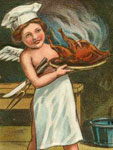At a Glance
Topics
Website
Features
Duration
Grade(s)
Lesson Format
Download
What Really Happened? Comparing Stories of the First Thanksgiving
Students read several versions of the story of the first Thanksgiving. They analyze the source and perspective of each version, and discuss the reasons that the story of the first Thanksgiving might generate so much controversy.
Review

This lesson does a good job of positioning students to understand and evaluate the perspectives of secondary sources on the First Thanksgiving. Students begin by establishing a common understanding of the "mainstream narrative" of the First Thanksgiving, either from their own experience, books on Thanksgiving written for young children, or a website like this one from National Geographic Kids. (Other, similar sites are also linked near the bottom of the lesson).
In groups, students then read accounts of the first Thanksgiving from one of four points of view: mainstream accounts, Native American educators and public school leaders, conservative and Tea Party activists, and Native Americans critical of the holiday. Multiple articles are provided for each category so teachers may choose the articles most appropriate for their students. After analyzing each category of sources in small groups, students come together as a class to discuss the various perspectives of the accounts they read. This is an ideal opportunity for teachers to highlight the importance of paying attention to source information and reading historical accounts with a critical eye.
Some modifications may be necessary depending on your students' ages, abilities, and background knowledge. Students may need additional background information on the sources depending on their familiarity with the different point-of-view groups. You may also need to modify some of the texts depending on students' reading levels. Also, see the rubric below for more background information and historically accurate information about the first Thanksgiving.
The lesson concludes with a series of discussion questions that do a good job of helping students to think more carefully about the social and political impact of accepted historical narratives. For example, "What's at stake in interpreting the story [of the First Thanksgiving]?" These questions help students start digging into why we remember the past in particular ways and compare stories about the past generated by collective memory with evidence-based accounts of the past.
Notes
| Field | Criteria | Comments | ||
|---|---|---|---|---|
| Historical Content | Is historically accurate? | Yes. One of the highlights of this lesson is that it requires students to compare accounts and judge the quality of evidence used in those accounts. |
||
| Includes historical background? | No. Teachers may want to explore the sites listed here. Among the sites listed, some of the most useful and easily accessed background information can be found here and here. |
|||
| Requires students to read and write? | Yes. The lesson requires only minimal writing, but does include some discussion questions that could be used as writing prompts. |
|||
| Analytic Thinking | Requires students to analyze or construct interpretations using evidence? | Yes. |
||
| Requires close reading and attention to source information? | Yes. Teachers will want to provide some background information on the various sources of the story, as understanding the perspective of each source is crucial to this lesson. |
|||
| Scaffolding | Is appropriate for stated audience? | Yes. Teachers may want to adapt some of the text for younger students or for English Language Learners. |
||
| Includes materials and strategies for scaffolding and supporting student thinking? | Yes. The Thanksgiving Interpretations Handout will help students organize and analyze source information for the accounts they read. |
|||
| Lesson Structure | Includes assessment criteria and strategies that focus on historical understanding? | No, but the discussion questions could be used as writing prompts and an assessment. This approach would provide a way for teachers to assess how well students have grasped the varying perspectives and supporting reasons discussed in the lesson. |
||
| Defines clear learning goals and progresses logically? | Yes. |
|||
| Includes clear directions and is realistic in normal classroom settings? | Yes. |
|||